Kindly prepared by Viv Miles – Trustee , Charities of Richard Poyntz & Others
“Our two cottages in question were built in 1929, they were gifted to the Charity originally to house retired farmers, but over the years the farms diminished and the Charity decided to house homeless retired persons, this recently changed again, due to the increase in our area of homeless younger people between the age of 48-65yrs, who we now consider. “
THE COTTAGES
They are one-bedroom properties, with tiny galley kitchens and very little cupboard space, nowhere to eat and it was hard for the residents to keep clean and tidy. They were very dark with no room to manoeuvre, especially if the person was disabled. They had old wooden outbuildings, used for coal that was rotting, very damp and cold.
When The Almshouse Association visited a few years ago, they emphasised the kitchens were not fit for purpose and suggested we knock the outbuildings down and build extensions. This was impossible at the time as the Charity had very limited funds, so the Charity decided it would be a project for the future, and with careful planning over five years, we at last felt we were able to fund a large part of the project. We also asked the Association for help and they most kindly offered us a loan of £50,000 and a grant of £20,000. The total cost of the project was £100,000 and we didn’t need to source any additional funds.
This was a very big project for a small Charity and if The Almshouse Association hadn’t helped, we most definitely wouldn’t be able to save the buildings, let alone build liveable working kitchen/dining areas, so as a Charity we can not thank them enough.
After three quotes we employed a local builder, Gary Foss. We applied to London Borough of Havering who indicated we needed planning permission as the plot is within the conservation area. This we were not expecting, as the extensions were within the permitted construction that would only normally require building regulation control, so a set of plans had to be drawn up and approved. It was granted, but it took 10 weeks, so this delayed the build, and of course cost extra money. The build started and the residents had to move all their belongings, we helped them as much as we could letting them use our office space and interacted with them all the time to make this transition as easy as possible. The build was carried out in phases.
PHASE 1 – KNOCKING DOWN OUTBUILDINGS
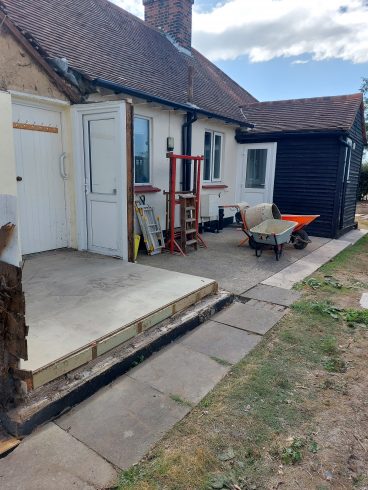
PHASE 2 FOOTINGS
PROBLEM 1 – BUSHES
On viewing the foundations and drainage, the Building Inspector considered that 18ft of bushes had to be removed as they were too near the new building and would impede the drainage. This also meant fencing had to be installed as it backed onto a farmers field.. i.e. more additional cost!
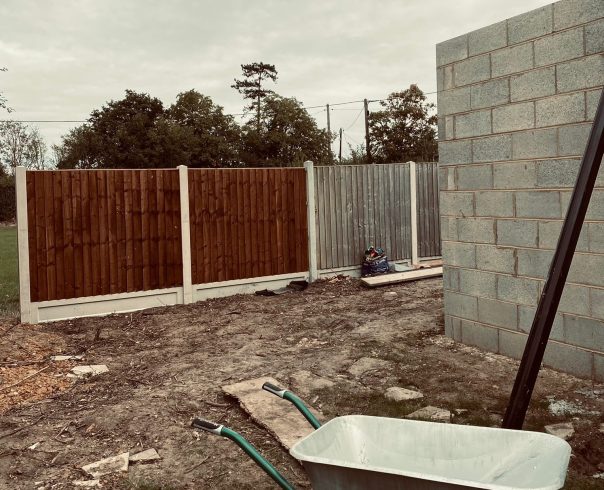
PHASE 3 – BUILDING THE EXTENSIONS
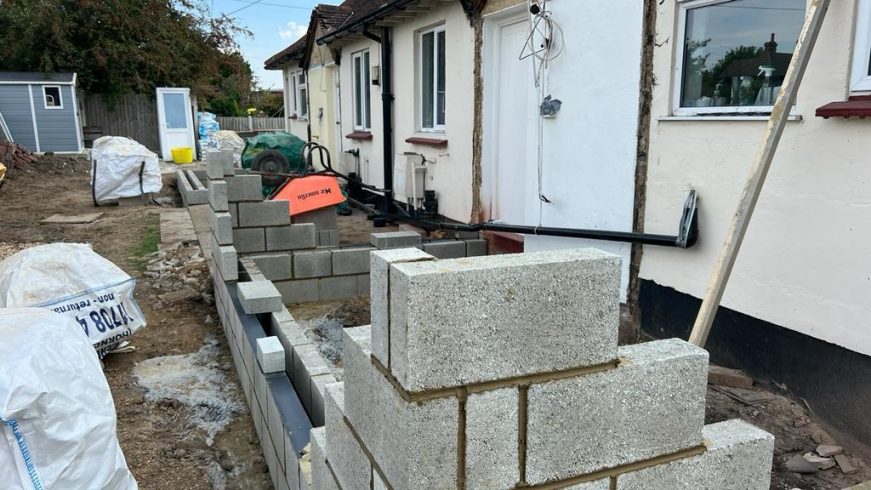
When the building work began, the builder noticed the No. 2 house alignment was wrong and started to investigate. He had already started the block work, but we now had another problem…
PROBLEM 2 – SUBSIDENCE
The builder had discovered subsidence. There was an enormous crack where the outbuilding was taken down that went down to the foundation level. The trustees decided the only course of action was to do the remedial work acknowledging there would be additional costs incurred.
To stop the problem once and for all, the builder recommended digging 2-metre trenches on each corner, going underneath what footings there are, placing acrows on a slab, then filling with concrete.
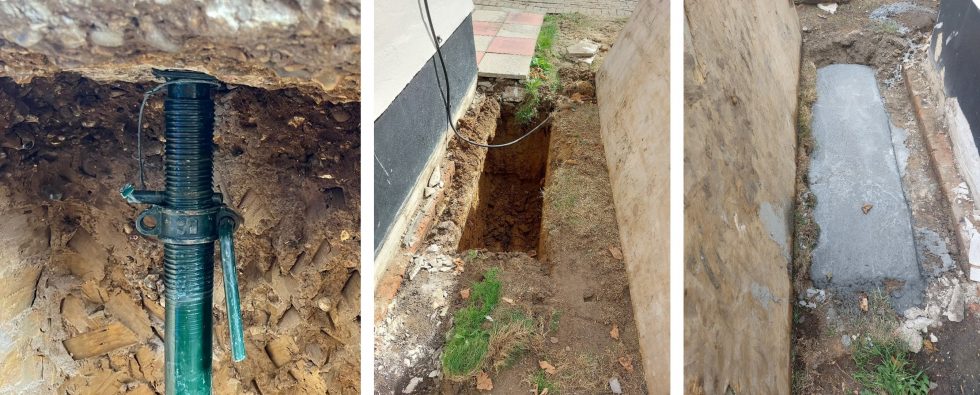
We agreed and the building work could then commence up to roof level including insulation work:
PHASE 4 – ROOF
London Borough of Havering altered the new roofs on both extensions as they considered them too high. This alteration also had a cost impact, but the build was now watertight ready for knocking through.
PROBLEM 3 – ROOF
The original roof has several problems including roof spread. There are no crossway beams so the roof is spreading causing tiles to slip. The roof tiles, which at some point had been replaced, are second-hand and crumbling. This problem, although temporarily fixed, will have to be completed at a later date.
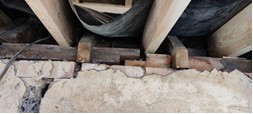
PHASE 5 – KNOCKING THROUGH
Acrows were installed ready for the main beam so walls could be knocked down and brick work installed to hold the beam. New windows and backdoors were reinstated, including first fix.
PHASE 6 – PLASTERING INSIDE & SCRATCH COATING TO OUTSIDE BUILDING
PHASE 7 – PAINTING TOP COAT
The Trust purchased the emulsion paint and the builder painted the initial coat, but the residents decided they would rather paint the topcoat.
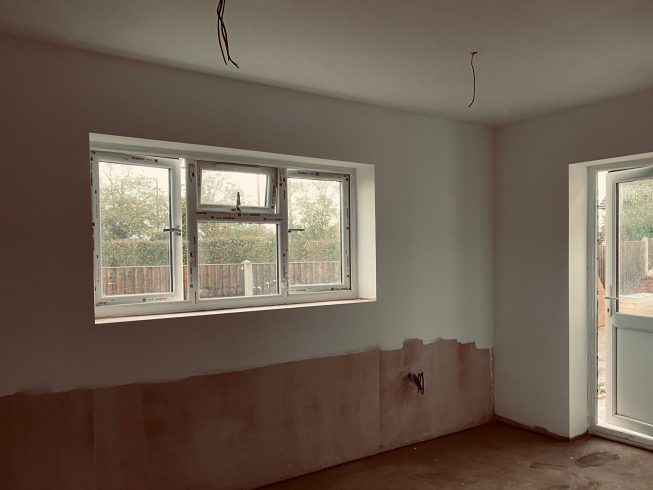
PHASE 8 – KITCHEN FITTING
The kitchens were bought from Howdens and the builder fitted them. Howdens were extremely good and gave us a large discount for the two kitchens with ovens, hobs and cooker hoods.
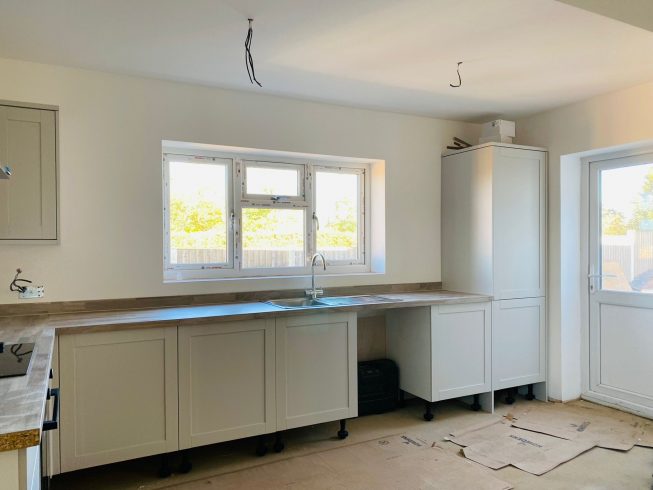 Kitchen before flooring and second fix electrics
Kitchen before flooring and second fix electrics
…. and with flooring, also undertaken by the builder, but bought directly by the Trust.
The residents have so much more space to be able to eat at a table and more cupboard space, plus they are now so much more accessible for anyone with disabilities.
“The new extended kitchen has made life so much better. I can now sit and eat at a table for the first time in years. The kitchen has really improved my quality of living and I can’t thank you enough”.
Resident A
PHASE 9 – MAIN COAT TO OUTSIDE OF BUIDINGS COMPLETED
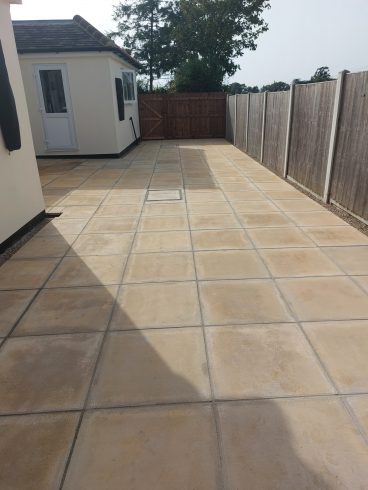 .
.
” We started with a really small kitchen, it has been a long process with a lot of surprising obstacles, but now we have an absolutely brilliant large kitchen/diner with wonderful colours, sharp straight lines and beautiful finish, the cottage is now much warmer due to all the new insulation, I am short a couple of plug sockets but overall I am very happy with what I have and live a better quality of life; I can go shopping weekly instead of every day, it has created a huge space I never thought possible, I can now resume normal life. I am very thankful for everything for all the work done and thank you to Vivienne and her husband for all the long hard hours you both spent working here to help”.
Resident B
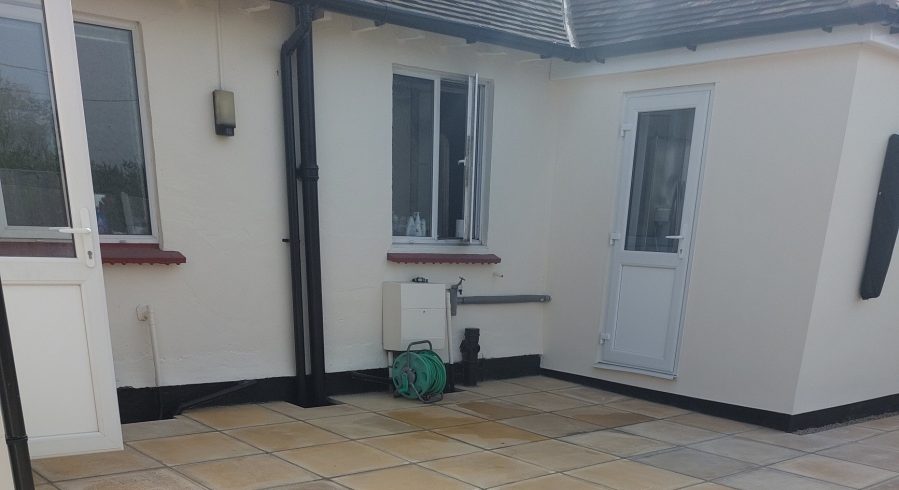
ADVICE TO OTHER SMALL CHARITIES
This experience has taught us so many things to look out for and here are a few:
- Make sure you have a contingency fund for any incidentals that may arise.
- When getting quotes, make sure you add every little thing you want built or fitted ie: building a cupboard and finishes, or employ a quantity surveyor.
- Appoint one person in charge you can trust, or a project manager, so they can make on the spot, important decisions. This helps the builder work to his schedule and they can pay him on time with every phase, especially if you use a small building firm. Do not pay your builder his final payment until he has completely finished and consult your fellow trustees before paying this.
- Always support the trustee/secretary that is in charge.
- Make sure at all times your residents are supported, as it can be very stressful, and if they move in with someone for the duration, keep them informed of the progress at all times.
“Our properties were finished to a high standard and the builder gave us loads of advice. The trustees were all very impressed with the work, as were the residents.”
posted August 2023